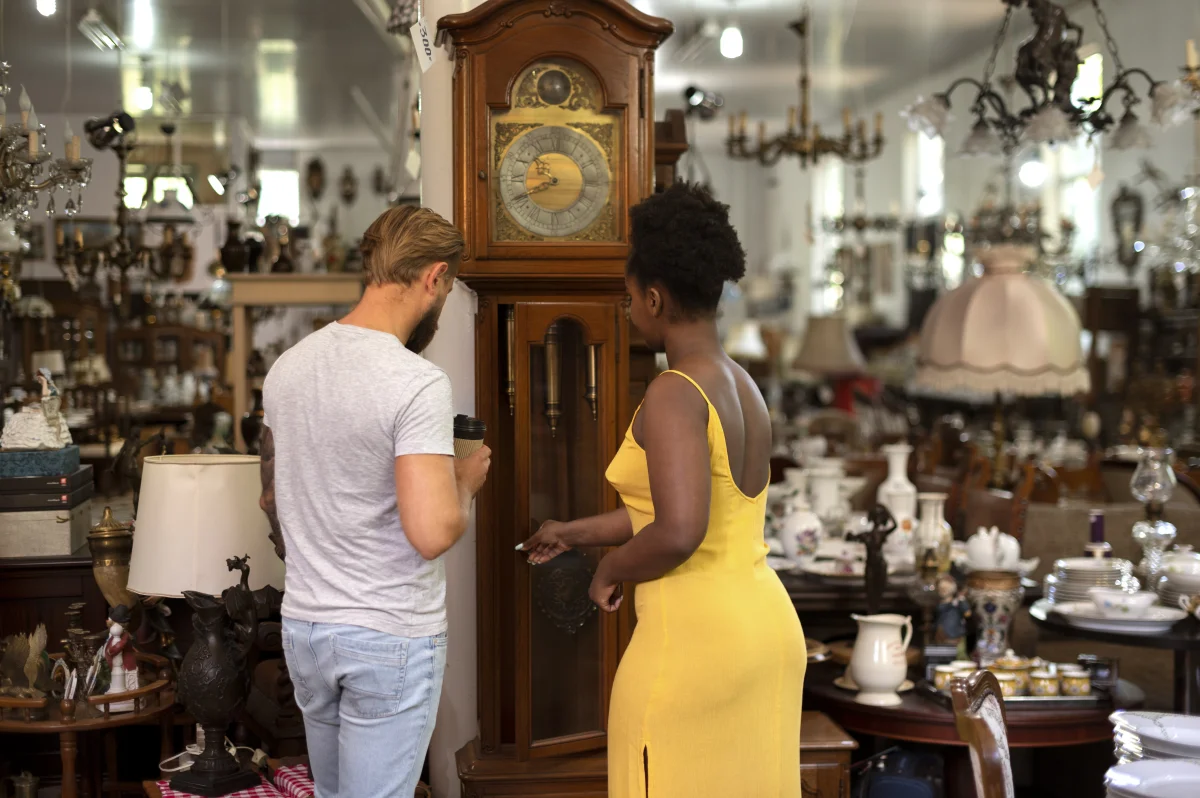This glossary demystifies the essential terminology you'll encounter in UK auction houses, from common bidding phrases to the more arcane descriptors found in catalog listings. Whether you're preparing for your first auction or simply curious about this venerable institution, understanding these terms will help you navigate the auction world with greater confidence.
Bidding Terminology
- Absentee Bid – A bid submitted in advance by someone who cannot attend the auction in person. These are executed by the auctioneer on behalf of the absent bidder up to a specified maximum amount.
- As Is – Items are sold in their current condition with no warranties or guarantees, and no returns accepted. This is standard practice for most auction houses.
- Auction Block – The podium or platform where items are displayed during the bidding process.
- Buyer's Premium – A percentage added to the hammer price that goes to the auction house as commission. Typically ranges from 15% to 30% depending on the house and item category.
- Chandelier Bid – A fictitious bid announced by the auctioneer, supposedly taken from an imaginary bidder (such as the chandelier). Used to create the impression of interest when bidding is slow. Also known as a "phantom bid."
- Commission Bid – Another term for an absentee bid, where the auction house bids on behalf of a client up to a specified amount.
- Conditions of Sale – The legal terms under which items are offered, typically printed in auction catalogs and binding on all participants.
- Estimate – The auction house's published opinion of what an item might sell for, usually given as a range (e.g., £500-700). Not a guarantee of value.
- Fair Warning – A phrase used by auctioneers to indicate that bidding is about to close on an item. "Fair warning" is typically the final chance for interested parties to place a bid.
- Hammer Price – The final bid amount at which an item is sold, excluding the buyer's premium and any taxes.
- Live Bid – A bid made in real-time during the auction, either in person, via telephone, or online.
- Lot – A single item or group of items offered for sale as one unit at auction.
- Opening Bid – The first bid made on a lot, often suggested by the auctioneer to start the bidding process.
- Paddle – A numbered card or electronic device used by bidders to identify themselves when placing bids.
- Passed or Bought In – Terms used when an item fails to sell because bidding did not reach the reserve price.
- Phone Bid – A bid placed by someone who is connected to the auction via telephone, with an auction house employee acting as their proxy in the room.
- Proxy Bidding – A system used in online auctions where you enter your maximum bid and the system automatically bids incrementally on your behalf until your maximum is reached.
- Reserve or Reserve Price – The confidential minimum price acceptable to the seller. If bidding doesn't reach this amount, the item remains unsold.
- Shill Bidding – The illegal practice of placing fake bids to artificially inflate prices.
- Winning Bid – The final and highest bid accepted, resulting in the sale of the item to that bidder.
Catalog Terminology
- After – Indicates that a work is done in the style of a particular artist but not by them or their workshop (e.g., "After Constable").
- Attributed to – Suggests that the work is probably, but not certainly, by the artist named.
- Circa (c.) – Approximately, used when exact dates are unknown (e.g., "circa 1850").
- Circle of – A work by an unidentified artist who was associated with the named artist but not necessarily their pupil.
- Follower of – Created by someone working in the artist's style, contemporary or nearly contemporary with them, but not necessarily their pupil.
- Manner of – A work in the style of an artist but created at a later date.
- Provenance – The ownership history of an item, often important for establishing authenticity and adding value.
- School of – A work by a pupil or close associate of the named artist, but not attributable to any particular student.
- Studio of – A work created in the artist's studio by pupils under the artist's direction.
- Workshop of – Similar to "studio of," indicating a work produced in the artist's workshop, possibly with their involvement.
Object Description Terminology
- Antique – Generally refers to objects over 100 years old.
- Cartouche – An ornamental tablet or scroll-shaped design often containing an inscription.
- Compo – Short for composition, a mixture of materials (often plaster, resin, and glue) used for decorative moldings.
- Distressed – Intentionally altered to give an appearance of age or wear.
- Faded – Colors that have lightened due to exposure to light.
- Faux – Artificial or imitation (e.g., faux marble).
- Giltwood – Wooden items covered with gold leaf or gold paint.
- Hallmark – An official mark stamped on items made of precious metals to indicate purity, date, and maker.
- Inlay – Decorative material inserted into the surface of an object, usually contrasting with the base material.
- Lot – A single item or group of items sold as one unit in an auction.
- Marquetry – Decorative patterns formed by inlaying small pieces of veneer in a wooden surface.
- Patina – The surface appearance that develops on an object due to age, wear, and oxidation. Often desirable in antiques.
- Provenance – The history of ownership for an item, which can significantly affect its value.
- Reeded – Having parallel convex moldings (the opposite of fluted).
- Repousse – A metalworking technique where a design is hammered out from the reverse side.
- Restoration – Professional repair work that has been done to an item to return it to its original condition.
- Veneer – A thin layer of wood (or other material) applied to a base of different material.
- Vintage – Generally refers to objects 20-100 years old, though definitions vary by category.
Specialized Categories
Bronzes
- Cast – The process by which molten bronze is poured into a mold.
- Edition – The number of casts made from an original mold. Limited editions are more valuable.
- Foundry Mark – The stamp identifying where a bronze was cast.
- Patination – The surface treatment applied to bronzes, creating distinctive colors and textures.
Furniture
- Campaign Furniture – Portable furniture designed for travel during military campaigns.
- Escritoire – A writing desk with drawers and pigeonholes.
- Japanning – European imitation of Asian lacquerwork.
- Pembroke Table – A small drop-leaf table popular in the 18th century.
- Refectory Table – A long, narrow dining table originally used in monasteries.
Jewelry
- Art Deco – Style from approximately 1920-1940 characterized by bold geometric patterns.
- Cabochon – A gemstone that has been shaped and polished rather than faceted.
- Parure – A matched set of jewelry pieces designed to be worn together.
- Paste – Glass made to imitate gemstones, common in antique jewelry.
Paintings
- Craquelure – The fine network of cracks that develops in paint as it ages.
- Giclee – A type of high-quality inkjet print, often used for reproductions.
- Impasto – Paint applied thickly so that it stands out from the surface.
- Medium – The material used to create artwork (oil, watercolor, acrylic, etc.).
- Original – A one-of-a-kind artwork, as opposed to a print or reproduction.
- Triptych – A work divided into three sections, often hinged together.
Silver
- Coin Silver – Silver with approximately 90% purity, historically made from melted coins.
- Engraved – Decorated by cutting into the surface with a sharp tool.
- Gauge – The thickness of silver sheet; higher quality items typically use heavier gauge.
- Sterling Silver – Silver alloy containing 92.5% silver, often marked with "925."
Auction House Roles
- Auctioneer – The person who conducts the auction, taking bids and declaring sales.
- Cataloger – A specialist who researches and describes items for the auction catalog.
- Consignor – The person who places items for sale at auction.
- Porter – Staff who handle, move, and display items during viewings and the auction.
- Specialist – An expert in a particular field (e.g., modern art, silver, furniture) who provides valuations and cataloging expertise.
Final Thoughts
While this glossary covers many common terms, auction terminology continues to evolve and varies somewhat between different houses and specialties. Part of the enjoyment of becoming an auction regular is learning the subtle language distinctions that mark you as an insider.
Don't be afraid to ask for clarification if you encounter unfamiliar terms—auction house staff are generally happy to explain, and even experienced collectors regularly encounter new terminology in specialized sales.
The language of auctions may initially seem designed to exclude newcomers, but it actually serves an important purpose: precision. In a world where subtle distinctions can mean significant differences in value and authenticity, having specific terminology helps ensure that buyers and sellers understand exactly what's being offered.

